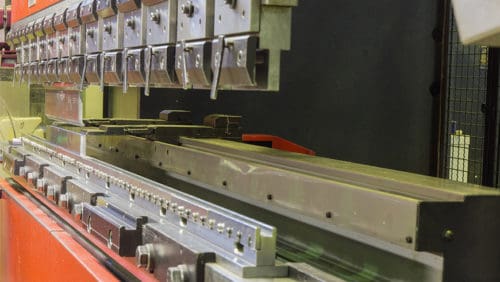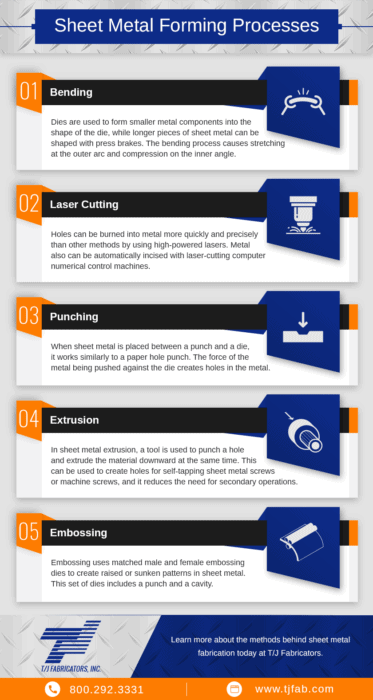 Sheet metal forming involves the use of force to deform metal without removing material. When the metal is carefully pushed beyond its yield strength — but not so far that it fails — it can be formed into shapes ranging from a simple bend to complex geometries. A range of precision sheet metal forming processes allow sheet metal to be fabricated, involving specialized equipment to stretch or shape the material.
Sheet metal forming involves the use of force to deform metal without removing material. When the metal is carefully pushed beyond its yield strength — but not so far that it fails — it can be formed into shapes ranging from a simple bend to complex geometries. A range of precision sheet metal forming processes allow sheet metal to be fabricated, involving specialized equipment to stretch or shape the material.
Bending
Dies are used to form smaller metal components into the shape of the die, while longer pieces of sheet metal can be shaped with press brakes. The bending process causes stretching at the outer arc and compression on the inner angle. Just as with any other flexible material, the metal tends to revert slightly after forming the curve; so, to compensate for the springback, this process requires strategically over-bending the metal.
Laser Cutting
Holes can be burned into metal more quickly and precisely than other methods by using high-powered lasers. Metal also can be automatically incised with laser-cutting computer numerical control machines. The lasers used are one of three types of lasers: CO2, neodymium, or yttrium-aluminum-garnet.
Punching
When sheet metal is placed between a punch and a die, it works similarly to a paper hole punch. The force of the metal being pushed against the die creates holes in the metal.
While the holes are seemingly created with one swift movement, in reality, it is a four-step process:
- The metal is deformed.
- The hole is scored or cut.
- The metal is broken along the cut line
- The punch slug is ejected.
Extrusion
In sheet metal extrusion, a tool is used to punch a hole and extrude the material downward at the same time. This can be used to create holes for self-tapping sheet metal screws or machine screws, and it reduces the need for secondary operations. The process is commonly used with enclosures, components for furniture, storage systems, and any other component that requires punching and extrusion.
Embossing
Embossing uses matched male and female embossing dies to create raised or sunken patterns in sheet metal. This set of dies includes a punch and a cavity. Metal thickness and properties determine the maximum depth of the embossing. This process can be used in the following applications:
- Function – Embossing can be used to improve a performance characteristic of a metal component. It can be used in a variety of ways, including reducing friction and static, enhancing traction, improving metal stiffness, or increasing surface area.
- Visual – Embossing produces patterns on sheet metal components that can be purely aesthetic. Applications include automotive trim elements, consumer products, or electronic enclosures.
Precision Sheet Metal Fabrication at T/J Fabricators
When your application requires precision and reliability, you need a company that has been proven to adhere to the strictest of quality standards. At T/J Fabricators, Inc., we hold ourselves to stringent standards of excellence, with the use of state-of-the-art equipment and digital scanning. For more information about our capabilities, contact us today or request a quote here.





